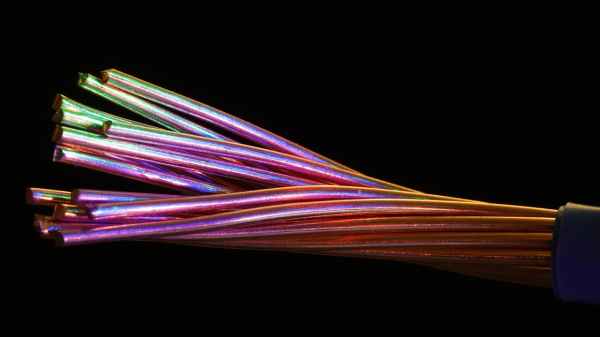Optical fibre can have different types depending on the way in which the light propagates, depending on the material it is made of, or depending on whether what reaches our home is optical fibre as such or, ultimately, by means of a coaxial cable.
Types of fibre according to the propagation of light
Depending on the paths followed by the light beams inside a fibre, i.e. its propagation mode, we can find two types of optical fibre: single-mode and multimode. Let us look at the main characteristics of each of them.
Single-mode
Single-mode optical fibre is characterised by a higher transmission rate and can reach up to 50 times more distance than multimode. However, it is more expensive.
The advantages of single-mode fibre include almost unlimited bandwidth and low attenuation, which is why it is used in long distance scenarios.
A single-mode cable is a single glass fibre bundle with a diameter of 8.3 to 10 microns that has one transmission mode. To put this figure into context, it should be noted that a human hair can range from 15 microns (very fine) to 170 microns (extremely coarse), with 60 to 110 microns being the most common.
Multimode
Multimode optical fibre has a larger diameter than single-mode, ranging from 50 to 100 microns. In most applications where multimode cable is used, two fibres are required.
Multimode fibre provides high bandwidth at high speeds, from 10 to 100 MB, although in long cable runs (over 914 metres) many light paths can encounter distortion problems, so single-mode fibre tends to be used in applications using Gigabit or more.
Depending on the refractive index of the core, there are two types of multimode fibre: stepped and graded.
Fibre types by material
On the other hand, and depending on the material, we can find two different types of fibre: glass or plastic. What are the characteristics of each of them?
As their respective names indicate, glass fibre is made of small strands of glass while plastic fibre has a core and a coating made of plastic or polymeric materials.
What are the advantages and disadvantages of each?
Glass optical fibre
Advantages
- Better withstands extreme temperatures, whether hot or cold.
- Enables higher transmission speeds.As thin and lightweight cables, they are optimised for small locations.
Disadvantages
- Complicated installations require both highly trained technicians and more expensive tools and equipment.
- Because the fibre core is very small, the technology requirements are higher.
- If not handled properly, glass fibres can break due to their fragility.
Plastic fibre optics
Let us now look at the pros and cons of plastic optical fibre, also known as POF (plastic optical fibre).
Advantages
- Installations tend to be cheaper as they are made of less expensive materials.
- It can be bent without problem as it is flexible and strong.
- Installation personnel may have a lower level of training than for glass.
Disadvantages
- Due to the high scattering and attenuation of the signal, it is used over short distances.
- Unlike glass, it is not suitable for extreme temperatures.
Fibre coaxial and fibre to the home: differences
Another concept that would be interesting to explain is that of fibre coaxial (HFC) and fibre to the home (FTTH). As a main idea, the main difference is that FTTH brings the optical fibre to our own home while in HFC the optical fibre technology reaches a node and from there to our home a coaxial cable arrives that allows the connection.
HFC
HFC fibre (Hybrid Fiber-Coaxial) could be translated as hybrid coaxial fibre. It was once used by cable TV companies to deliver their content to the home, and over time it has been used to provide Internet connectivity by taking advantage of the infrastructure already in place.
The reason for combining fibre optic and coaxial cable is economic, since, as we have seen throughout the article, glass fibre is more delicate and expensive.
FTTH
Unlike coaxial (copper) cables, fibre uses glass, as we have seen above. The FTTH (Fiber to the home) concept implies that the entire network is fibre optic.
Previously, other types of FTTx networks (FTTB, FTTN, FTTC or FTTA) were common, which essentially carried the fibre, respectively, to the building, the node, a cabinet similar to the node, or an antenna.
Therefore, these FTTx networks would be similar to HFC since they do not carry fibre strictly to the home.
Conclusion
Throughout the article we have analysed different types of fibre optics that may exist, depending on the material it is made of, how the light beams are transmitted or whether or not it is actually the fibre that reaches the home.









